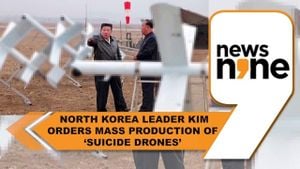Geopolitics has undergone significant transformations over the past decade, with one of the most notable changes being the rapid ascent of Asian countries, particularly China. This dramatic growth of the Chinese economy has enabled Beijing to increase its clout on the global stage, positioning itself as a formidable challenger to the established world order. Observers of international relations often view China's rise with suspicion, prompting traditional powers to question its intentions and strategies.
At the heart of this transformation lies the "peaceful rise" doctrine cited by Chinese leaders since 2003. According to this doctrine, China aspires to integrate peacefully within the global framework, asserting its influence without resorting to aggression. This strategy has facilitated China's management of border disputes, the enhancement of relationships with regional organizations, and the expansion of trade ties, as noted by various analysts.
Given China’s growing footprint across global geopolitics, as well as its advancements in economic and technological spheres, reviewing the tenets of the peaceful rise doctrine sheds light on how China showcases itself as both a global leader and manages internal pressures. Can Beijing sustain this approach as it navigates complex international waters?
Chinese President Xi Jinping has recently underscored the importance of military readiness among China’s airborne troops, calling for enhanced combat preparedness. This directive highlights the strategic necessity of the People’s Liberation Army (PLA) Airborne Corps, especially considering the looming possibility of conflict over Taiwan. Xi's visit to the Airborne Corps headquarters marked his first inspection of this unit, where he emphasized integrating paratroopers fully within the PLA's operational framework. This includes aligning with broader modernization goals.
During his inspection on November 4, Xi called for "all-out efforts" to boost training, improve technical capabilities, and bolster mission readiness. Notably, he endorsed advanced equipment such as cutting-edge reconnaissance drones and armored infantry vehicles equipped with defensive technology to counter potential threats. These improvements signal China’s readiness to ramp up its military capabilities.
Analysts have long speculated about the PLA’s Airborne Corps playing a pivotal role should conflict arise over Taiwan. Hipthis strategic branch of the military, historically established as a rapid response unit, carries the enduring mission of “liberation” of Taiwan. Xi’s recent directives reflect China’s insistence on preparing for possible military operations, signaling increased urgency to refine the operational readiness of these airborne forces.
The idea of airborne invasions has been buoyed by insights gleaned from recent military conflicts, particularly the Russia-Ukraine war. The failure of Russian forces during the botched seizure of Hostomel Airport offers invaluable lessons for Chinese strategists weighing similar operations. This pivotal operation intended to establish rapid airlift capabilities for Russian troops became emblematic of the unforeseen complications inherent to airborne missions.
Strategic failures during the Hostomel operation included poor coordination and logistical hurdles, resulting in significant operational setbacks for Russian forces. The Ukrainian resistance proved to be more organized and determined than anticipated, demonstrating vulnerabilities faced by airborne units if surrounding areas are not swiftly secured.
Russian troops initially captured Hostomel Airport on February 25, 2022, but the operation quickly devolved due to mounting resistance from Ukrainian forces, leading to substantial losses. High-profile casualties included the killing of Major General Andrei Sukhovetsky. This scenario unfolded as Russian forces struggled to maintain control, demonstrating the frailty of executing such ambitious airborne missions without adequate preparation.
Chinese leadership is likely to reflect on these lessons as they strategize their own military operations. The neglected need for clearing areas surrounding the targeted objectives has emerged as a poignant lesson. Hostomel's siege didn’t just reveal flaws within the Russian command strategy; it highlighted the vulnerabilities airborne operations face when hindered by logistical barriers and lack of operational flexibility.
Currently, Taiwan's President, William Lai Ching-te, continues to affirm his nation’s policies aimed at safeguarding autonomy from Chinese claims, setting off alarms within Beijing. Observing Taiwan’s military maneuvers and responses provides insights on how Beijing may face significant challenges if it opts for militaristic solutions. The external pressures on the island nation to defend against potential airborne advances reinforce the necessity for China's military to demonstrate readiness and capability.
While the PLA continues to develop its airborne capabilities, its modernization efforts are well-timed with what many are calling the West's strategic pivot toward Asia. China's responses to perceived threats and its calls for rapid increase of its military capabilities demonstrate the acuteness of geopolitical calculations as other nations reassess their positions.
Understanding Xi’s recent military directives, along with the fundamental shifts witnessed via the peace rise doctrine, indicates China’s rigorous commitment to shaping its position as not just another world power, but as one prepared to assert its interests, whether through diplomatic means or military might. With the historical backdrop of numerous conflicts serving as cautionary tales, the world watches closely.
Meanwhile, the Taiwan issue continues to be at the crux of regional tensions. Navigational challenges within this domain must be carefully addressed if China hopes to maintain its doctrine of peaceful rise. How each side chooses to respond could define the geopolitical climate for decades to come, illustrating the balancing act involved when asserting influence on the global stage. Will the lessons learned from past military operations catalyze more cautious approaches, or will they embolden aggressive tactics? Only time will reveal the strategies shaped by history as China plots its future path.



